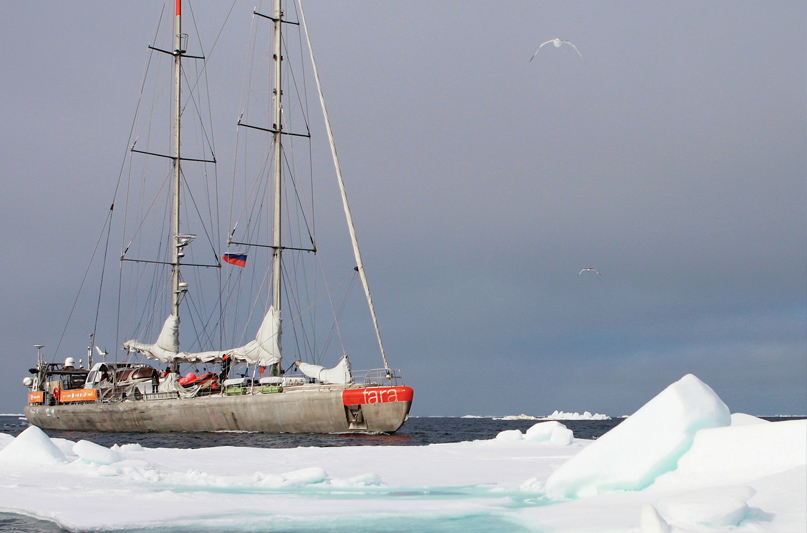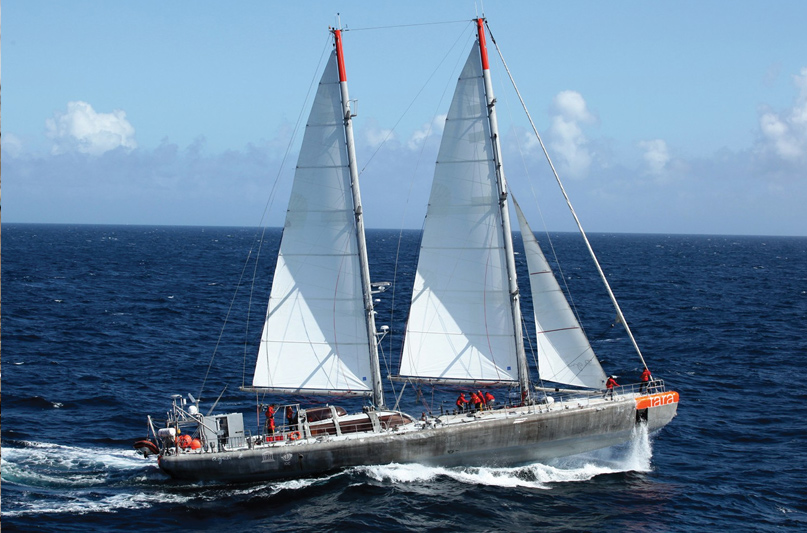 It was back in July, in the heart of the summer, when I spotted a big schooner-rigged sailing vessel at the East Mooring Basin in Astoria, Oregon. From a distance, I could see it was at least 100 feet long, built of unpainted aluminum, and flying a foreign flag. This combination of traits was unusual enough to draw me along the bridge to the gangway that leads down to the dock. That’s where I met three crewmen who were stretching their legs and waiting for the immigration officers to arrive. They spoke English with a French accent and I decided to try out the high school French that I have managed to hang on to for over 50 years. They appreciated my attempt, but English won out as we walked back to the boat past some aging trawlers and tuna boats. What I saw next was something so unique that it ranks high on my list of nautical encounters.
It was back in July, in the heart of the summer, when I spotted a big schooner-rigged sailing vessel at the East Mooring Basin in Astoria, Oregon. From a distance, I could see it was at least 100 feet long, built of unpainted aluminum, and flying a foreign flag. This combination of traits was unusual enough to draw me along the bridge to the gangway that leads down to the dock. That’s where I met three crewmen who were stretching their legs and waiting for the immigration officers to arrive. They spoke English with a French accent and I decided to try out the high school French that I have managed to hang on to for over 50 years. They appreciated my attempt, but English won out as we walked back to the boat past some aging trawlers and tuna boats. What I saw next was something so unique that it ranks high on my list of nautical encounters.
The French sailing research vessel Tara is a working boat over 100 feet long (119’ LOA) with a convex aluminum hull whose curve seemed to continue below the waterline. Any thought that it might have been a yacht conversion was eliminated by the sight of the many dents that covered the hull and must have been caused by some extremely heavy collisions. But despite my years of experience seeking out unusual craft, I resisted the temptation to guess what it could have collided with so frequently, although the evidence led to only one conclusion: this could be the world’s first ice-breaking sailboat.
My excuse was that my mind was busy wondering whether this hard-working, big boat was previously skippered by New Zealand’s greatest yachting hero Peter Blake, on whose deck he had been killed by pirates on the Amazon River.
What I saw from the dock was that the Tara is rigged with two identical masts that may use one of the biggest, heaviest extrusions available. The shrouds looked like they could support a small suspension bridge, and the turnbuckles were as big as my arm. I learned later that the research vessel was designed by the French naval architect firm of Bouvet-Petit especially for exploration of the polar regions. The CNM shipyard in Cherbourg, France, built the strengthened aluminum hull in 1988 with rounded bilges and topsides, and shallow draft to deal with subzero temperatures and pack ice. As ice forms around her hull, she is lifted not crushed.
“We wanted a boat that is easy to handle, with a schooner rig – the idea being that two sailors could maneuver the boat and take a reef quite easily,” explained naval architect Oliver Petit recently to media.

Tara‘s first owner in 1989 was French polar explorer Jean-Louis Etienne, who undertook several voyages to the polar regions. The vessel was then purchased by famed New Zealand racing sailor Sir Peter Blake, who named the ship Seamaster, and made it the base for his environmental protection program with the support of the United Nations Environment Program. Blake was tragically shot and killed by the aformentioned pirates who attacked the ship on the lower Amazon in 2001.
In November, 2003, the ship was purchased by famed French fashion designer Agnès Troublé and renamed Tara, the name Blake’s grandfather had chosen for his ship, which means “Celestial Path” in Maori. Its most famous exploit was in the Arctic during 2006-2008 when the ship was iced in and the crew drifted for 507 days across almost 2,000 miles, studying interactions between air, sea, and ice flows to better understand the impacts of a warming planet.
“We knew the boat would be covered with snow, and that it must not collapse under the weight. It had to have rounded shapes everywhere. Hence the very compact form, the igloo-shaped superstructures,” Petit recalled.
The latest cruise on this sail-powered research vessel will circle the Pacific Ocean for over a year with 70 stopovers. From Astoria, the crew were on their way to Portland, Oregon to introduce their marine science work to Portland at OMSI (the Oregon Museum of Science and Industry). The busy program in the city was organized by one of the voyage sponsors with a local office—and a rather inscrutable name—Billerudkorsnäs. It is a leading producer of renewable packaging material, which matches one of the goals of the Tara Expeditions Foundation. OMSI was running an interactive water exhibit called Planktonic Plastics in the Oceans during the visit.
“This Portland port of call is an opportunity to explain our work and raise awareness about the ocean, including coral reefs impacted by climate change, and also the research on plastic pollution,” said Romain Troublé, executive director of the Tara Expeditions Foundation. The previous stop was Hawaii, after which the ship crossed the subtropical gyres where the biggest concentration of plastics exists and collected samples of seawater containing garbage ranging from disposable containers to microscopic plastic particles. Most plastic in the ocean breaks down into tiny particles, which attract colonies of microorganisms that eventually coat the plastic and cause it to sink. Besides carpeting the ocean floor in a plasticine layer, the micro-organisms smell like food to fish—a fact that could have far-reaching consequences. Ted Wheeler, mayor of Portland, visited the crew and participated in a forum on plastic waste.
“It’s not a war against plastic—it’s a war against waste. Plastic is very important for many, many things we use today,” Troublé explained.

After catching up on the boat’s trip up the Columbia River, I must admit I made another minor error. I assumed I was doing this research purely for my own interest, because it would all be well covered by the media when the Tara arrived on the Salish Sea. It was a surprise to check the web site in August and find that the schooner did not sail north after it crossed the Columbia Bar, it headed south!
From the log of the Tara:
“Navigating under full sail takes place smoothly, a feat for the 140-ton Tara. She advances at a speed of 10 knots, with peaks at 16 knots. At this steady pace, the schooner sails 250 nautical miles in one day. This is the highest speed recorded during the Tara Pacific expedition. Using the HSN (High Speed Net) and Dolphin nets, the oceanographers took their first samples of water and plankton. Often called the blue lung of our planet, the ocean is filled with billions of micro-algae that eject as much oxygen as all of the world’s forests!”
The crew headed straight to San Diego, Calif., for three days onshore, and was soon on its way to Central America and the Panama Canal and then home to Brittany, France.
At the start of September, the Intergovernmental Conference on Biodiversity opened in New York with the aim of defining an international treaty to manage biological resources on the high seas. The Tara Foundation has been working on this subject for 6 years by defending the definition of a framework for high seas research and management of marine genetic resources. André Abreu, director of international policies of the Tara Foundation, spoke about the importance and challenges of these negotiations and the expected impacts for the scientific community. The expedition is scheduled to return to Lorient on October 27 at the sailing center and museum Cité de la Voile Éric Tabarly.
“I think we fulfilled our contract,” said the ship’s architect Oliver Petit as the boat prepared for the Atlantic crossing. “After nearly 30 years, the boat has had three successive lives. We could never have foreseen this. The boat has moved far beyond us. It no longer belongs to us at all.”